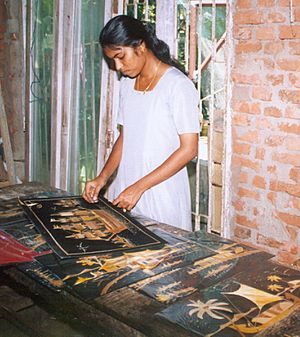Straw painting facts for kids
Straw paintings are amazing artworks made by carefully shaping and arranging pieces of straw to create pictures and designs. People, especially women, first started playing with straw and weaving it into artistic objects. Over time, they became very skilled. About a hundred years ago, they developed a special art form: weaving straw into detailed pictures. They used the natural colors and shades of different grasses like oats, barley, rye, and wheat. These unique "paintings" are now famous in places like China, Mexico, and Subotica in Serbia.
Contents
Straw Art Around the World
Straw art is a traditional craft found in different parts of the world, each with its own special style and history.
Straw Art in China
Straw patchwork art is a very old Chinese folk art. It began during the Han Dynasty (around 250—230 CE) and grew more popular during the Sui Dynasty (581—618 CE). In ancient China, people thought wheat was sacred. Because of this, wheat-straw patchwork was very rare and was only given to the royal family as a special gift.
During the Eastern Han Dynasty, wheat straw paintings were made for religious practices in the royal court. People believed wheat was a lucky plant that could bring good fortune. This craft almost disappeared for a while due to wars and big changes in society. However, it officially came back during the Sui and Tang dynasties. In the Sui Dynasty, it was a special craft made only for the emperor. Later, during the Song Dynasty (960—1127 CE), royalty continued to enjoy straw patchwork. The art was lost again but later reappeared in the Chinese provinces of Henan, Guangdong, and Heilongjiang.
How Chinese Straw Art Was Revived
In Heilongjiang, straw art was brought back in the 1960s. Young artists traveled to other provinces like Fujian and Shandong to learn about wheat painting. They then added their own ideas to create a unique style of wheat straw painting from Harbin.
In Henan, a folk artist named Liu Limin helped bring the art back in the 1980s after many tries.
Making Chinese Straw Art
To make these delicate artworks, wheat straw goes through many steps. It is smoked, steamed, whitened, dyed, and carefully cut. Today, wheat straw patchwork is a beautiful decorative art. It is also a popular souvenir for tourists visiting China.
Straw Art in Mexico and California
In Mexico, straw mosaics are known as "popotillo art." This name comes from popote de cambray, which is the Spanish name for sacaton grass (Sporobolus). This art form has very old roots, going back to the Pre-Columbian times before Europeans arrived. Some people think popotillo art might be a mix of Chinese straw art and the Royal Aztec Feather Art. Chinese immigrants who came to Mexico in the late 1800s to build the train system might have influenced this cultural blend.
Where Popotillo Grass Grows
The special grass used for popotillo art grows in Mexican states like Mexico, Morelos, Hidalgo, and Puebla. Mexico City is a main center for popotillo art. Several award-winning artists have even formed a workshop there called "Popotillo y Color." While popotillo art was common in the 1800s, it became most popular in Mexico City during the 1930s and 1940s. Workshops for popotillo art have also been offered in Los Angeles, California, by artist Francisco J Fraide.
How Mexican Popotillo Art is Made
First, the grass is dyed by hand. Before Europeans came, only natural dyes were used. The straw was often soaked in aguamiel, which is juice from the agave plant.
Next, the artist draws a design. This design is then covered with a thin layer of "cera de Campeche," a special type of beeswax. The straw is cut into small, usable pieces, sometimes as tiny as one millimeter long. The artist then carefully presses these tiny straw pieces into the beeswax. Once the design is complete, a fixative (a protective spray) is put on the artwork to keep it safe.


